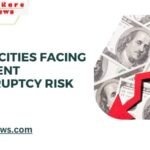As economic landscapes evolve, certain U.S. cities find themselves at the precipice of financial instability. In this article, we delve into ten such cities facing imminent bankruptcy risk. Understanding the underlying factors and potential remedies is crucial for charting a path towards economic recovery and sustainability.
Chicago, Illinois: Pension Liabilities and Fiscal Strain
Explanation: Chicago grapples with an overwhelming burden of unfunded pension liabilities, which exerts immense fiscal pressure on the city’s resources. The need for pension reform and innovative revenue generation strategies is paramount.
Detroit, Michigan: Economic Decline and Urban Flight
Explanation: Detroit’s economic decline, exacerbated by population outflow, has strained city finances. Focusing on economic diversification, urban revitalization, and job creation is essential to reverse this trend.
Also Read: 15 US States That Have the Most Annoying People
San Bernardino, California: High Debt Service Costs
Explanation: San Bernardino faces substantial debt service costs, limiting its capacity to invest in critical services and infrastructure. Implementing debt restructuring and cost-effective financial management practices is imperative.
Providence, Rhode Island: Structural Budgetary Imbalance
Explanation: Providence contends with a structural budgetary imbalance, wherein recurring expenses exceed revenue streams. Prioritizing expenditure review, revenue enhancement, and strategic planning is crucial for fiscal stability.
Camden, New Jersey: Poverty and Limited Tax Base
Explanation: Camden struggles with high poverty rates and a limited tax base, hindering revenue generation. Initiatives to spur economic development, expand the tax base, and address poverty are vital for long-term financial health.
Oakland, California: Housing Affordability and Gentrification
Explanation: Oakland faces challenges related to housing affordability and gentrification, impacting the socioeconomic landscape. Balancing urban development with affordable housing initiatives is crucial for inclusive growth.
New Orleans, Louisiana: Vulnerability to Natural Disasters
Explanation: New Orleans grapples with vulnerability to natural disasters, necessitating substantial investments in infrastructure resilience. Mitigating environmental risks and enhancing disaster preparedness are paramount for the city’s financial stability.
Gary, Indiana: Deindustrialization and Economic Downturn
Explanation: Gary’s struggle with deindustrialization has led to economic downturn and population decline. Diversifying the local economy, attracting new industries, and job creation efforts are critical for resurgence.
Scranton, Pennsylvania: Escalating Pension Costs
Explanation: Scranton faces escalating pension costs that strain the city’s financial resources. Implementing pension reform measures and exploring innovative revenue streams are vital for fiscal sustainability.
Hartford, Connecticut: High Fixed Costs and Pension Obligations
Explanation: Hartford contends with high fixed costs and pension obligations that limit financial flexibility. Addressing pension liabilities and pursuing cost-saving measures are essential for long-term fiscal health.
Conclusion
Navigating the challenges of imminent bankruptcy risk requires a multifaceted approach encompassing fiscal reform, economic diversification, and strategic planning. By addressing the underlying factors contributing to financial instability, these cities can chart a path towards economic resilience and sustainability.
FAQs
It is possible to prevent bankruptcy by adopting proactive financial management, strategic planning, and the required reforms.
By putting pension reform policies into place, looking at alternative investment options, and expanding revenue sources, cities can reduce their pension commitments.
Cities may draw in new sectors by putting money into infrastructure, hiring trained labor, giving incentives, and fostering an atmosphere that is conducive to doing business.
Cities may adopt inclusive zoning policies, promote the creation of affordable housing complexes, and implement rent control measures in an effort to achieve a balance between urban expansion and inexpensive housing.
Cities may make significant investments in dependable infrastructure, create all-encompassing strategies for disaster preparedness, and carry out community outreach and education.












